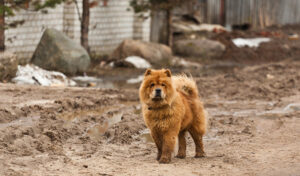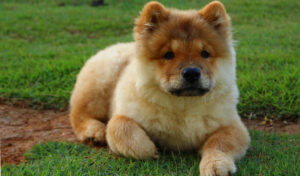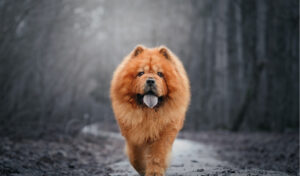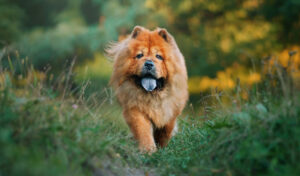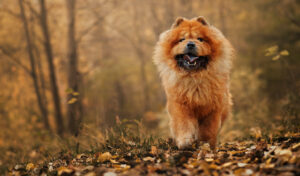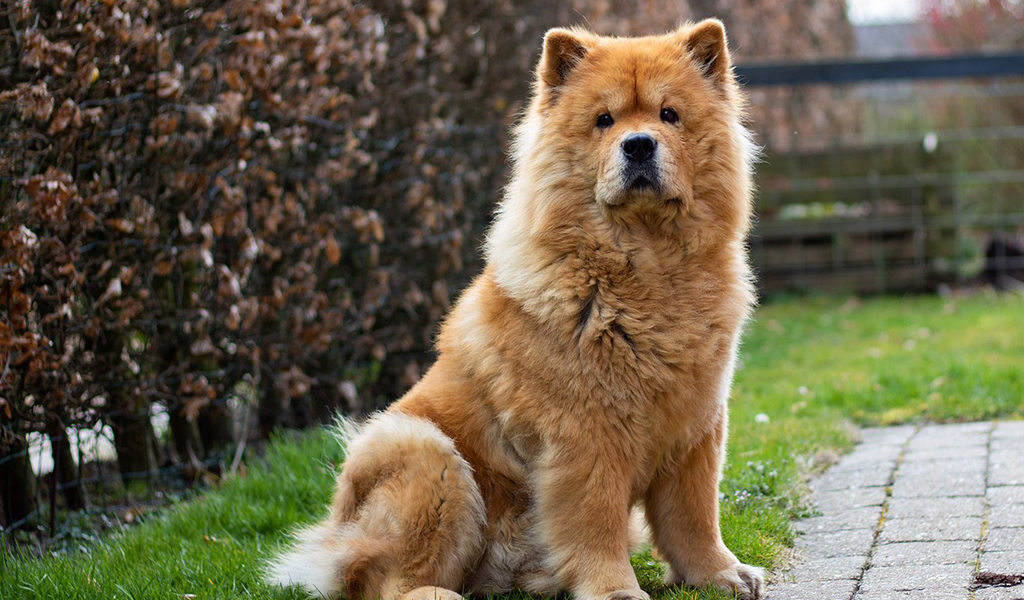What is a Chow Chow Breed?
Chow Chow is a medium-to-large dog breed from northern China. The breed head is large and can be flanked by long hair, giving the dog a lion-like appearance. The distinct-appearing A haughty, independent personality that some have compared to a cat characterises the Chow Chow dog breed.
Because they are an independent breed, these puppies may need to perform some things on their own terms and require persistence and patience. They are quite wary of new people. They can, however, make devoted friends for the appropriate individual.
These dogs are able to adapt to apartment living, but they require a lot of activity and dislike spending extended periods of time alone at home. You may have a devoted, guarding furry family member by offering skilled training and enough of physical activity.
Content Overview
- History
- Different names
- Appearance and Characteristics
- Personality and Temperament
- Health & problems
- How to take care
- Puppy Information
- Puppy price
- Things to consider adopting a puppy
- Advantages & Disadvantages
- Photo gallery
Chow Chow History
Chinese relics from the Han Dynasty include images of the Chow Cha, one of the most unusual and potentially oldest breeds in the world. In its lengthy history, Chow has had a variety of responsibilities. He was occasionally a peer of the Chinese aristocracy.
They did also make a living as guards, transporters, and hunters over the years. The breed’s name has a more widely accepted reason that has to do with British Empire commercial ships from the 18th century. Back then, little, unrelated objects in a ship’s cargo were referred to as “chow chow” in Pidgin English.
In the 1820s the Chow Chow was featured in the London Zoo as the “wild dog of China”. The Chow was declared a recognized breed by the AKC in 1903 after first being exhibited in America in the 1890s.
Different Names or Types
Chow Chow Other Names
- Cho-Cho
- Pipinola
- Pear squash
- Vegetable pear or Choko.
Recognized Names
Recognitions
- FCI: Fédération Cynologique Internationale
- AKC: American Kennel Club
- CKC: Continental Kennel Club
- ANKC: Australian National Kennel Council
- NZKC: New Zealand Kennel Club
- UKC: United kennel club
Appearance & Characteristics
A non-sporting medium- to large-sized dog breed from China, the chow dog is distinguished by its lion- or bear-like look and its blue-black tongue. The fur has a characteristic ruff or mane look around the neck, where it is particularly thick and black.
The coat has formerly been either cream, black, blue, cinnamon, fawn, or black. Chow are large, powerful dogs, it is a sturdy-built dog with a square in profile. It has short, triangular, upright ears with rounded ends. The breed is distinguished by a highly dense double coat that can be either rough or smooth.
The eyes of a these Chows are typically deep set and almond shaped. the is unique their purple or blue-black tongue and has very straight hind legs. The bluish color extends to the Chow’s lips this is the only dog breed with this distinctive bluish color in its lips and oral cavity.
Breed basic characteristics
- Country of origin: China
- Breed group: Non sporting
- Life Span: 11-13 years
- Size: Large
- Height: 17-22 inch
- Weight: 35-70pounds
- Coat: Thick and Coarse
- Type: Purebred
- Shedding: Seasonal
- Colors: Red, Cinnamon, Black, Cream, White or ivory
- Also as known: Cho-Cho, Pipinola, Pear squash, Vegetable pear or Choko.
- Good with children: Yes
- Personality traits: Aloof, Independent, Loyal, And Quiet
- Good with pets: Yes
- Barking: Infrequent
- Competitive registration: AKC
Chow Chow Size: The Chow Chow is a medium-sized dog that stands between 17 and 20 inches tall and weighs between 50 and 75 pounds.
Eyes: Chow Chow eyes are usually deep set and almond shaped.
Ears: Chow Chows have erect and floppy ears.
Body: Strong
Coat
They have two different types of coats. Because of their straight, close-up coats, Chow Chow puppies resemble fluffy teddy bears. Both coat varieties have thick undercoats. Although red or black are the most common colors for the Chow Chow, any solid color is acceptable.
Color and Markings
Common coat colors for this breed include.
- Red
- Black
- Blue/Sliver
- Sand
- Fawn
- Cream
- Cinnamon
- White
- Mahagoni red/Orange
Coat Color and Markings
The only difference between these different species of chow is the difference in color. It has two types of coat. This is a straight, close-up coat. The coat is red, black, blue, tan or cream in color.
Personality and Temperament
Personality Of Chow Chow Dog
The disposition of the Chow Chow has led some people to compare it to a cat. A good Chow should never be aggressive or timid, despite its loudness. Chow often keep to themselves and don’t cause problems.
Strangers are not interesting to them until they enter the chow’s home without permission from its owner, in which case it will challenge the visitor. Otherwise, they will play with their own humans. He will, however, let outsiders pet him if one of his owners introduces them.
Owners claim that Chows are the cleanest breed of dog since they are as sociable as cats, easy to housebreak, and have no dog odor.
Temperament Of Chow Chow
This Chow dog tends to cling to only one person and is independent and dignified. The Chow dog is devoted to his entire family and is undoubtedly protective of them. He may be hostile with unknown Dogs and has a low level of trust towards strangers.
The Chow is an extremely possessive breed. Their thunderous scream alerts passersby or strangers. Chows dogs are incredibly devoted to their family and exceedingly loyal. This breed is sharp-witted yet stubborn, and anything that offends him will be treated with a firm warning.
When aggression does occur, it frequently affects dogs of the same gender, particularly Chows. These dogs remain contained, on leashes, and away from cats and other small animals.
Activity Requirements
Due to their size, Chows only need 40 to 60 minutes of exercise every day on average. There should always be a few walks and some time for play off-leash in a secure area. Despite residing in an apartment, Chows has to exercise often. It’s best to take quick strolls three to four times daily.
The energetic and alert Chow breed has modest activity requirements. The Chow needs regular strolls and mild toy play, but not excessive roughhousing or vigorous exercise. Exercise should be avoided during the hottest parts of the day because the breed is not adapted to high temperatures or humidity.
This calls for socializing the dog with both people and other Dogs. Take him to a place where he can socialize with other dogs and new people, such as a dog park or a neighborhood park.
During the sweltering summer months, exercise should be performed earlier and later in the day when it is cooler and more comfortable for dogs.
Trainability
The Chow breed has moderate exercise needs and is active and alert. Dedication and persistence will be needed to train this Chow Chow. Chows require light toys and frequent walks but not rough play or strenuous activity.
The breed is not acclimated to extreme temperatures or humidity, thus exercise should be avoided during the warmest portions of the day. Always keep in mind that this dog is autonomous and will want to make its own decisions. Shorter training sessions with more incentives are necessary for smaller Chow Chows.
This calls for socialization between the dog and both people and other dogs. Take him to a park in area or a dog park so that he may interact with other dogs and new people. Exercise should be performed earlier and later in the day when it is cooler and more comfortable for the dogs during the hot summer months.
Health & problems
Despite being a generally healthy breed, chow chows can have certain genetic health problems. The genetic nature of many illnesses and medical conditions indicates that they are bred-related.
The breed is susceptible to seizures, hypothyroidism, diabetes, cataracts, allergies, hip dysplasia, and luxating patella. Less common breed-related diseases include deafness, heart disease, and dwarfism.
Hip dysplasia : Hip dysplasia is brought on by a malformed hip joint, which can cause arthritis and irregular gaits. Hip dysplasia may be treated surgically or with pain medication, depending on the degree.
Patella luxation: The ailment known as patella luxation occurs when the knee joint becomes sloppy. Cases can range from moderate to severe, and they are often hereditary in nature.
Diabetes: When a dog has diabetes, their body is unable to control how sugar is metabolized, which leads to lethargy, increased drinking and urine, and dehydration.
Glaucoma: Dogs who have glaucoma, which causes increasing pressure in the eye, may experience pain and go blind.
Feeding Plan
When deciding how much to feed a Chow Chow it is important to keep in mind that every dog is unique. Each Chow Chow has different nutritional needs, depending on their size, age and activity level. It can be confusing, but feeding a Chow Chow puppy is a fun and exciting duty.
The nutritional needs of Chow Chow puppies during the first month of their lives can be met by their mother’s milk alone. its pups under the age of a year old should be fed four times each day. Adults just need to eat three times daily. On the other hand, senior Chow Chows may survive on just two meals every day.
Compared to other dogs in their class, Chow Chows often eat less. As puppies, they can eat ¾ to 2 cups of dry food per day, and as adults, they can eat 2 ½ cups of dog food per day. Senior Chow Chow dogs, however, are limited to 2 to 3 cups of dog food per day.
Living conditions
Despite being a huge dog breed, the chow chow is nonetheless capable of residing in an apartment. In reality, the chow may be fairly content in an apartment since he doesn’t need much activity. Family is important to chow chows, and they are protective of them.
They require extensive early socialization, including exposure to kids, to develop into suitable family pets. Chow chows perform best when trained to establish their place in the family; otherwise, they risk becoming domineering. The kind of coat affects how it is groomed.
The easiest way to prevent tangles on a chow chow with a tough coat is to groom him every day. Despite the difficulties in training, some chow chows participate in obedience and agility competitions and perform well.
How to take care of Chow Chow?
Chows can live in a range of apartments, including palaces and houses. However, they should always be kept indoors with their owners and never confined to a kennel or backyard. Keep them indoors when it’s hot outside because they don’t handle heat well.
A Chow Chow adult requires regular exercise to keep healthy and content, just like any other dog. It is important to provide them a healthy food per a veterinarian’s recommendation. They should be cleaned up after and given a bath.
Grooming & Brushing
Chow can have either a rough or smooth coat. The typical appearance of the rough coat is thick and plentiful, standing off from the body like a parka. A silky, dense undercoat made of wool lies beneath that outer coat. Around the head and neck, where the hair is denser, a ruff or mane forms. The tail, which hangs over the back, has a lot of fur as well.
To maintain the coat in good condition and stop loose hair from getting on clothing and furnishings, plan on brushing the Chow Chow three times a week. The coat requires additional care during the Chow Chows’ considerable seasonal shedding.
A medium-coarse toothed stainless steel greyhound comb, medium-sized slicker brushes for the legs and body, medium pin brushes, and a spray bottle of thin coat conditioner are all necessary for brushing.
Other grooming requirements include nail maintenance and dental hygiene. To get rid of tartar and germs, brush dog’s teeth at least twice or three times every week. Daily is preferable. If necessary, perhaps once or twice a month, trim her nails.
Also Read: Maltese Dog Breed
Feed Healthy food
These dog may maintain a healthy weight, gain lean muscle mass, and attain their optimal weight with the appropriate nutrition. Omega-3 fatty acids help dog move around more, which improves general health and wellbeing.
The Chow is a powerful, hardy dog that needs a balanced diet to stay healthy. Chow owners are urged to cook home-cooked meals for their protein-sensitive Chow Chow. Include rice in the meals as it helps the Chow Chow to have good skin and a healthy coat and is easy for them to digest. Additionally, excellent sources of protein for chow chow include eggs and cottage cheese.
The following items should never be feed to Chow Chow
- Yeast dough
- Onions, chives, and garlic
- Poultry bones
- Chocolate, coffee, or tea
- Alcohol, beer, wine or liquor
- Tomato leaves stem or unripe fruit
- Moldy or spoiled food of any kind
- Salt & salty foods
- Grapes or raisins
Puppy information
Chow Chow Puppy Training
As with all dogs, a Chow Chow dog should be trained as soon as it is brought home. The basic commands of sit, stay and come should be taught, but since animals are smart you can add other commands as well.
It is important to socialize puppies, take them outside and give them as many opportunities as possible to bond with other people and animals while taking care to protect the puppy from unpleasant experiences.
Behavioral training
Behavioural training is essential for all dogs. Every dog owner has to do some dog behavior training at some point. The training of the dog’s behavior is highly beneficial for dog care.
If you wish to train a puppy, start by identifying some typical behavioural problems, such as aggressiveness, food guarding, howling, mouthing and chewing, separation anxiety, etc. You can then put an end to these problems and train your dog quickly.
Obedience training
This is the most basic and crucial training for every dog. There are three different ways to teach the Chow Chow, all of which begin with a strong foundation in the five basic obedience commands: come, sit, stay, heel, and down.
These 5 basic obedience commands should be taught to all dogs. Get Chow Chow dog into obedience training and properly teach the dog the basics of obedience because every dog benefits from obedience training.
Socialization
All dogs need socialization, and it’s crucial. Giving pets as many different experiences as you can at a young age is the greatest way to socialize them. Introduce them to a variety of sights, sounds, textures, and environments.
Furthermore, you should provide kids chances to form positive interactions with both humans and animals. In order for chow chows to mature, socializing is the most important stage. A well-behaved dog and a dog that may be dangerous can be distinguished by proper socialization.
Chow Chow puppies for sale
The Chow Chow is a breed of dog that has an intriguing appearance and an even more intriguing personality. He is well renowned for looking adorably lion-like. The Chow is immediately recognizable, with a royal, dignified look and a fiercely devoted character.
The Chow Chow is an excellent guard dog and faithful friend. A Chow Chow puppy may be purchased for between $1,200 and $2,000 from reputable breeders.
Things to consider adopting a Chow Chow
- This breed is inappropriate for a family with small children or a first-time dog owner.
- Chow Chow are thought to be exceptionally bright dogs, they are notoriously challenging to teach.
- Unfortunately, this breed has a long list of medical and health problems, which may make you worry that they are suffering from problems specific to their breed.
- They are among the greatest guard dogs due to their protective instincts.
- This dog is not the best option for you if you dislike frequent grooming.
- The Chow Chow is not the best breed to choose if you want a sociable dog for visitors and neighbors. Chow is prohibited in several regions due of this, among other reasons.
Advantages and Disadvantages
Advantages of Chow Chow
- They are very loyal to their owners
- They are protective of their family
- He is an excellent watchman
- He is an independent and devoted companion
Disadvantages of Chow Chow
- extra maintenance is necessary.
- Unsuitable for novice dog owners.
- They can become hostile against other animals and strangers if they are not properly socialized.
Chow Chow Photo Gallery
